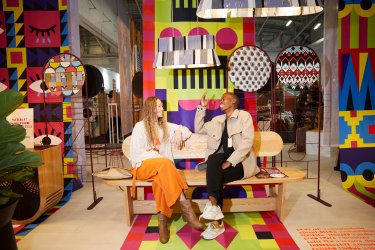Ahead of ideating for Decorex 2023, Bielle Bellingham, Executive Creative Director of RX Africa shares brainpickings and inspirations from 2022’s London Design week. Quizzed extensively, she offers sincere reassurance that Africa is more visionary and relevant than ever before. With the help of tech and digital accessibility, new voices are advocating for the future of design and bring with them a new wave of individualism, storytelling and diversity – a platform with previously limited narratives and far removed from today’s tantalising world of possibility.
Expectation versus Reality
Before my trip to London Design Week, I had very high expectations and a sense of urgency to get on top of all the latest design trends, technologies, and techniques, as I believed I may have been behind due to the Covid travel hiatus. But, I soon realised that the South African design industry is not quite as behind as I had incorrectly thought. With the easy access to real-time information today, we’re able to stay up to date.
Adding Layers… Sustainably
Despite this realisation, I was still inspired by the level of creativity and innovation on display, and enjoyed seeing how designers are pushing the boundaries of what is possible. The strong emphasis on sustainability was particularly exciting to see.
Inspiration for Africa
The Africa Fashion exhibition at the V&A was the undeniable highlight of my trip, as it signifies a significant step towards greater recognition and appreciation of African fashion and design on the global stage. The exhibition acknowledges the global impact of African fashion and the growing demand for more authentic and representative design.
Africa is a continent not a country
I was particularly impressed by the exhibition’s focus on foregrounding individual African voices and perspectives, rather than presenting a homogenised view of African fashion. By showcasing the unique talents and creativity of African designers, the exhibition inspires a new generation of designers and creatives to push the boundaries of what is possible in African fashion and design. Moreover, it underscores the potential of the African fashion industry to drive economic growth and create jobs in any and every region.
Why local talent, resources and Afrocentric equity matter
Investing in African design, and shaping an industry that celebrates diversity, is crucial in breaking down historical power imbalances. I thoroughly believe that by championing African design and promoting its cultural and economic value, we can create a more equitable, and sustainable future for all. Supporting local design and creators not only helps to preserve and promote cultural heritage, but also encourages innovation and creativity, which can create economic growth and job opportunities in the region.
What design story does bringing all three major trade events under one roof tell in the context of South Africa?
Aligning the three biggest design trade exhibitions in South Africa has the potential to create a powerful, unified brand for South African design, which stimulates the creative economy. By attracting both local and international exhibitors and visitors, the three co-locating events accelerate business growth, create new jobs, and generate significant revenue for the country. This helps to develop local manufacturing and production capabilities, reducing the country’s dependence on imports and strengthening its economic resilience. In addition, aligning these exhibitions can inspire a shared design vision for South Africa.
Pushing boundaries
By showcasing the latest trends, technologies, and innovations, our aim is to ignite local designers and manufacturers to push the boundaries of creativity and develop products and services that meet the changing needs of the market. This will foster a culture of design excellence and innovation, essential for sustained growth and success in the industry.
Design is more than the sum of its creativity
As a community of designers, manufacturers, and stakeholders, we have a responsibility to use our collective authority, reach, and scale to create awe-inspiring, next-generation experiences and products. We must protect and strengthen our environment while empowering new modes of expression and community action. By breaking old codes and inviting our partners to actively participate in the co-creation of the design industry, we can ensure that South African design continues to thrive and evolve for years to come.
Why decolonising design matters
Historically, Africa has experienced significant barriers and power imbalances that have limited the full expression of its creative potential. Colonialism, economic exploitation, and cultural imperialism have all contributed to the marginalisation of African creativity and the suppression of local talent and industries.
Design does not happen in a vacuum and cross-cultural collaboration and exchange of ideas are vital for creative growth and innovation. But, at this critical juncture, I believe that it is crucial to support and celebrate African creativity on its own terms, recognising and respecting Africa’s very unique creative voice and experiences. By doing so, we can unlock the full potential of our creativity which will contribute to a more diverse, inclusive, and sustainable global design industry.
Sensory mediums like film, music and even podcasts are part of a bigger picture…
The democratisation of the design industry through new media art forms can help to level the playing field and amplify the voices of a diverse range of creatives, leading to richer and more varied output that truly represents the multiplicity of experiences and perspectives in the country.
Want to know what Bielle gets up to on an average day?
Featured image: Supplied

